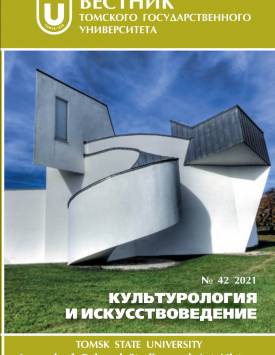Contrast in political cartoons of the Great Patriotic War
The article has for an object to determine themes of the Great Patriotic War cartoons based on the contrast between of two pictures and to detect and describe aims that cartoonists try to achieve with help of the political cartoons under study. The author conducts research of the Great Patriotic War cartoons created by Kukryniksy, a group of caricaturists, which M.V. Kupriyanov, P.N. Krylov, and N.A. Sokolov belonged to. They often involved S.Ya. Marshak in the work on the verbal part of their political cartoons. Some of the political cartoons under study give an example of wholeness of his rhymes and the painter's pictures. The author treats the political cartoon of the Great Patriotic War as a message that is addressed to the Russian language personality and is a polycode one, which presupposes that information, which caricaturists code into the cartoon, is a result of cooperation between iconic and verbal means. Using Yu.N. Karaulov's idea about the structure of the language personality, the author describes the encoding-decoding process of political cartoons meaning, in forming of which codes of different semiotic systems take part, as projections onto different levels of the language personality where these projections activate a certain string of associative links. The analysis of the political cartoons under study made it possible to detect five themes discussed in them: change of the state of things, change of personage's emotional state, personage's intention and results of its realization, action-and-reaction, personage's mask and his real identity. Describing the political cartoons, the author ascertains that, combining two pictures based on the contrast within the bounds of a political cartoon, the caricaturists fulfill specific range of tasks. (1) The contrast of pictures, which contain both similar and different elements, furthers directing and holding of addressee's attention. The caricaturists stimulate the addressee of the message to an active search for similar and different elements on those pictures, which diverts the addressee. (2) The contrast in the political cartoon can produce comical effect or increase it. The more cloudless the situation is for the personage on the first picture, the clearer it is to everyone how abased he is on the second one. (3) The contrast of situations with different characteristics (the one in the past and another in the present / the real situation and its hypothetical projection) in a message in the form of a political cartoon can have an explanatory function. The evil depicted on the first picture serves as proof of rightfulness and necessity of counteraction to it. If the form of such counteraction is shown on the second picture, the message contains an indirect appeal to the addressee for his active counteraction to this evil. (4) The usage of contrast for discussion of the theme “personage's mask and his real identity” enables to show the true face of him, to give his personality a certain estimate and to form addressee's opinion of the characterized person.
Keywords
comical effect, background knowledge, Russian language personality, aims of political cartoons, contrast, cooperation of verbal and iconic means, Kukryniksy, political cartoon, Great Patriotic WarAuthors
| Name | Organization | |
| Denisova Galina L. | Togliatti State University | g.denisova@tltsu.ru |
References

Contrast in political cartoons of the Great Patriotic War | Tomsk State University Journal of Cultural Studies and Art History. 2021. № 42. DOI: 10.17223/22220836/42/7
